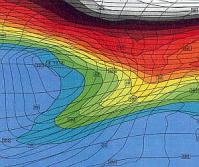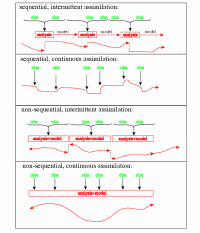Data Assimilation for Problems with Large Dimensions in Climate and Ocean Modelling
| Working Group: | Former WG Numerics |
| Leadership: | Prof. Dr. Angelika Bunse-Gerstner (E-Mail: bunse-gerstner@math.uni-bremen.de ) |
| Processor: | Dr. Caroline Böß |
| Funding: | DAAD |
| Project partner: |
Alfred-Wegener-Institut für Polar- & Meeresforschung Prof. Dr. Nancy K. Nichols, University of Reading, Großbritannien European Centre for Medium-Range Weather Forecasting Met Office (Reading) |
| Time period: | 01.04.2004 - 31.03.2017 |

This research project addresses the development of numerical methods for data assimilation tasks for problems with very large dimensions in climate and ocean modelling. The data assimilation uses numerical simulations and continuously updated measured values to obtain forecasts about the development of the observed environmental systems which are as accurate as possible [?, ?, ?, ?]. Simulations in these fields use dynamic systems as mathematical models, said systems being able to approximately describe the time-dependent behaviour of the quantities of interest, such as pressure, current, temperature etc., in the region under observation. The multiplicity of dependencies and the size of the regions to be observed mean that these systems have extraordinarily large dimensions. An order of magnitude of 107 is quite usual. Even on the fastest computers, the tasks facing us here for systems with such large dimensions cannot be solved directly in a reasonable time. The requirement that the mathematical models be continuously adjusted using the latest measured values thus necessitates the development of many models with smaller dimensions which nevertheless adequately approximate the system behaviour so that a meaningful adaption to the measurement data can be made. Apart from the extremely large dimension of the systems, an additional difficulty with these tasks from meteorology and oceanography consists in the fact that the problems are often of the so-called ill-posed type, something which has virtually been ignored and not dealt with as yet. This project focuses on the following three objectives:
- The development of new numerical methods for ill-posed inverse problems with very large dimensions, in furtherance of [?], to improve the variation methods in data assimilation.
- The investigation of the suitability of model reduction approaches in regulation and control to improve the efficiency of the data assimilation methods using the example of the incremental 4D var method [?, ?, ?] and to analyse the sensitivity with the aim of improving the selection of the data to be considered according to the position of the measuring stations [?].
- The development of structure-conserving methods for systems with special structural properties (systems which satisfy equations of conservation and the like)
This project is currently still at a stage where possible methods under development for examples with typical behaviour but still only several hundred variables can be tested on PCs and workstations if these are fast enough. Test computations of the dimension 400 can be performed in 10 seconds. In a later phase, in which up to 107 dimensions will be considered, it will be necessary to switch to parallel or vector computers and to finally implement them with super computers. A future collaboration is planned for this project with the Alfred Wegener Institute.


